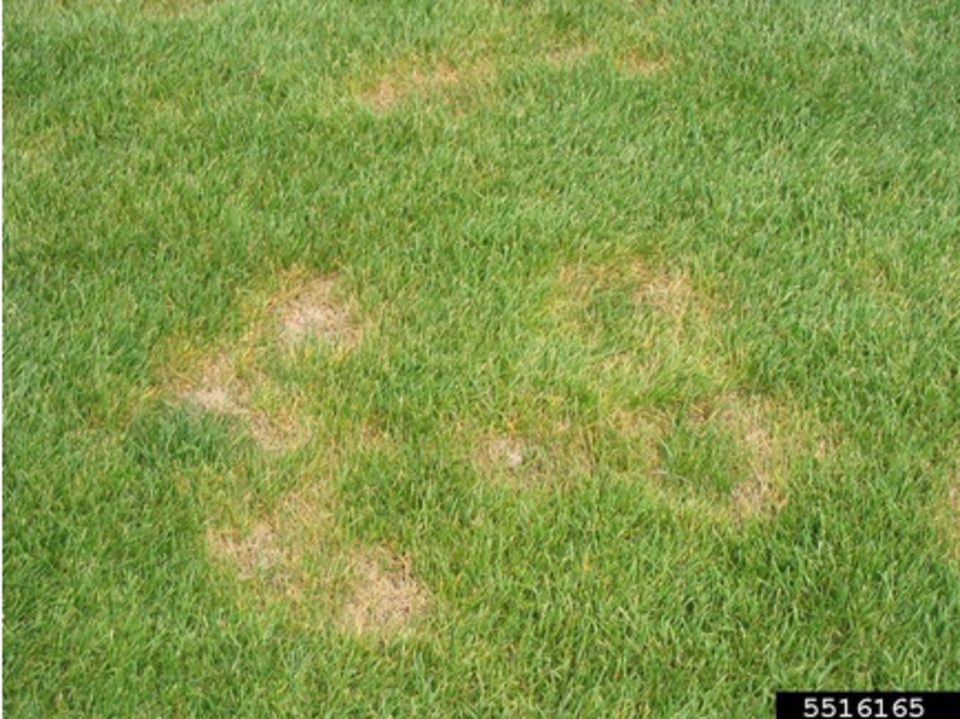Fungi Can Develop from Improper Irrigation

Fungi can be very problematic for our plants, and there are a lot of different fungi. In plants, there is a disease triangle that leads to plant diseases. For disease to develop, you must first have a pathogen, a susceptible host, and a favorable environment. Pathogens are common in the environment and just waiting for the right weather to occur and a susceptible host to infect. The environment can sometimes be altered by our plant management practices, such as overwatering or underwatering and improper irrigation practices can lead to more disease problems. That’s why it's so important, whenever possible, to choose disease resistant plants for our landscapes – both turf, fruits, vegetables and ornamentals.
The photo above of Summer Patch is from Lee Miller, University of Missouri, Bugwood.org
Fungi in Lawns
There are many fungal pathogens which can infect susceptible turfgrasses; three of the most common are dollar spot, brown patch, and summer patch. These diseases show up nearly every year. Their severity is often due to the presence or lack of favorable weather conditions and our management practices.
Proper irrigation and fertilization can help reduce the incidence of these diseases. Heavily fertilized turf is more susceptible to infection, so don’t push your lawn with too much nitrogen. Follow recommendations for a moderate lawn fertilization plan, using the guidelines below.
- Cool Season Lawn Calendar – Western Nebraska, https://extensionpubs.unl.edu/publication/2124
- Cool Season Lawn Calendar – Eastern Nebraska, https://extensionpubs.unl.edu/publication/2114
Maintain the lawn’s overall health and vigor, enabling it to recover from minor disease infection, through proper irrigation. Don’t water late in the day and allow the grass blades to be wet during the nighttime. This creates a period of extended leaf wetness which is ideal for fungal infection. When irrigating, water to the bottom of turf roots to develop a deep, extensive root system and improve overall plant vigor.
- Water-Wise: Water Use Guidelines, https://hles.unl.edu/documents/WaterDogs/21.04.13.Water%20Use%20Guidelines%20compressed%20v3.pdf
- Water-Wise: Water Needs of Common Turfgrass Species, https://hles.unl.edu/documents/WaterDogs/21.04.13.Common%20Turf%20Species%20compressed%20v3.pdf
However, summer patch develops more often following a wet spring, which we have no control over.
Fungi in Gardens
In our garden spaces – ornamental landscape beds and vegetable gardens - many different fungi can appear and are often made worse due to improper irrigation. Just as in turf, leaf wetness and excess nitrogen favor leaf spot diseases. In the vegetable garden, water droplet splashing during irrigation or rain is a major factor in leaf infections.
Best Irrigation Practices
In lawns, it is best to irrigate early in the morning, between 4am and 10am. This allows leaves to dry throughout the day. Also, irrigating early in the morning will wet the grass when it is already damp from the morning dew. Finally, less irrigation water is lost to evaporation, than would occur later in the day due to higher winds and hot temperatures.
For landscape plants and gardens, it is also best to irrigate early in the morning. Avoid overhead irrigation as much as possible. Instead, a better option is to use soaker hoses or drip irrigation which places the water at the base of the plants, right onto the soil surface.
Just as in turf, a long period of wetness on the leaves of ornamentals or edibles leads to increased disease development. Also, overhead irrigation causes more water splashing and moves disease spores from the ground up onto the plants to begin the infection cycle.
Bottomline - How much water is available to your turfgrass and landscape plants affects their overall health and vigor. And how the water is applied can have a big impact on disease severity. So, when working in your garden and irrigating your lawn this spring and summer, follow these guidelines for the best health of your plants.